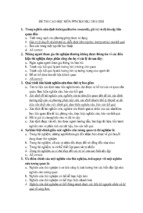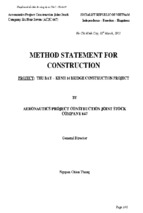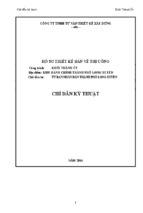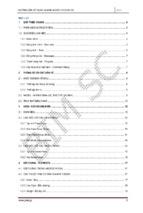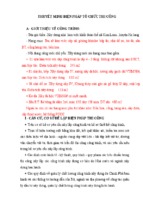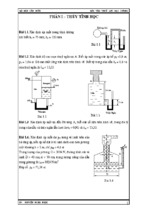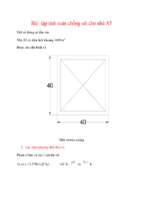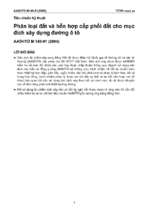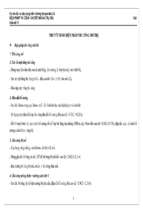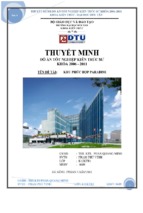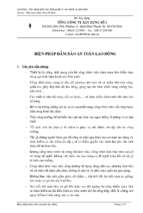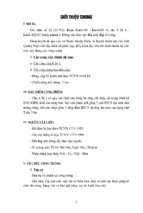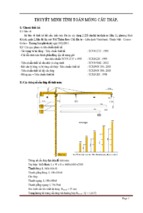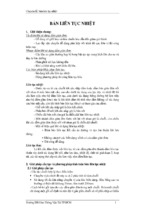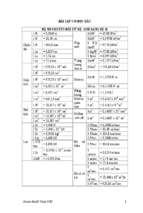Stationary 3D crack analysis with Abaqus
XFEM for integrity assessment of subsea
equipment
Master’s Thesis in Applied Mechanics
MICHAEL LEVÉN
DANIEL RICKERT
Department of Applied Mechanics
Division of Material and Computational Mechanics
CHALMERS UNIVERSITY OF TECHNOLOGY
Göteborg, Sweden 2012
Master’s thesis 2012:35
MASTER’S THESIS IN APPLIED MECHANICS
Stationary 3D crack analysis with Abaqus XFEM for
integrity assessment of subsea equipment
MICHAEL LEVÉN
DANIEL RICKERT
Department of Applied Mechanics
Division of Material and Computational Mechanics
CHALMERS UNIVERSITY OF TECHNOLOGY
Göteborg, Sweden 2012
Stationary 3D crack analysis with Abaqus XFEM for integrity assessment of subsea
equipment
MICHAEL LEVÉN
DANIEL RICKERT
© MICHAEL LEVÈN, DANIEL RICKERT, 2012
Master’s Thesis 2012:35
ISSN 1652-8557
Department of Applied Mechanics
Division of Material and Computational Mechanics
Chalmers University of Technology
SE-412 96 Göteborg
Sweden
Telephone: + 46 (0)31-772 1000
Cover:
The von Mises stress field of a cracked specimen subjected to tension using XFEM in
Abaqus.
Chalmers Reproservice
Göteborg, Sweden 2012
Stationary 3D crack analysis with Abaqus XFEM for integrity assessment of subsea
equipment
Master’s Thesis in Applied Mechanics
MICHAEL LEVÉN
DANIEL RICKERT
Department of Applied Mechanics
Division of Material and Comput1tional Mechanics
Chalmers University of Technology
ABSTRACT
Subsea equipment provided by FMC is used under the most extreme conditions in the
North Sea and is exposed to severe functional and environmental loading conditions.
Today, assessment of cracks and crack growth are based on handbook standards. The
implementation of a new fracture mechanics based approach to analysis may
significantly extend equipment life while improving model accuracy and system
reliability. Crack modeling using conventional FEM is accurate, but problematic with
respect to modeling. Therefore, an investigation of crack modeling using the extended
finite element method (XFEM) is conducted. The method simplifies the modeling of
cracks by adding a priori knowledge of the solution in the finite element space.
Modeling cracks using conventional FEM can be cumbersome due to the fact that the
mesh has to match the crack geometry. XFEM alleviates this shortcoming and allows
the crack to be represented independently of the mesh.
The XFEM tool in Abaqus is evaluated for three dimensional stationary cracks with a
variety of parameters and features such as meshing technique, element size, symmetry
and submodeling. The purpose is to find a robust and flexible strategy to model
cracks. The strategy is verified through handbook cases modeled in Abaqus, where
the accuracy has been evaluated. Reference cases in the thesis consist of three
dimensional closed-form solutions of finite plates with various crack configurations.
Also finite plates including cracks at holes/notches have been studied. The Mode I
stress intensity factor acquired for the crack configurations serves as the main
parameter in the comparison between models.
Good agreement between the XFEM Abaqus analyses and the closed-form handbook
solutions is found for general cracks, with errors ranging between three and ten
percent. XFEM models of cracks placed by holes and notches give insufficient
correlation with the closed-form solutions, with as much as 100 percent disagreement.
Based on the evaluations and obtained results, a strategy for general crack modeling is
proposed.
Contents
ABSTRACT
I
CONTENTS
III
PREFACE
V
1
1
2
INTRODUCTION
1.1
Background
1
1.2
Purpose
2
1.3
Limitations
2
1.4
Objectives
2
1.5
Method
3
1.6
Thesis outline
3
THEORY
2.1
Linear elastic fracture mechanics
2.1.1
Crack approximation
2.1.2
Stress intensity factors
2.1.3
Contour integral evaluation
3
4
4
4
5
6
2.2
FEM model
2.2.1
Governing equations
2.2.2
Material model
2.2.3
Elements
11
11
12
12
2.3
XFEM framework
2.3.1
XFEM enrichment
13
14
2.4
Benchmarks
2.4.1
Benchmark case 1: B1
2.4.2
Benchmark case 2: B2
2.4.3
Benchmark case 3: B3
2.4.4
Benchmark case 4: B4
2.4.5
Benchmark case 5: B5
17
17
18
19
19
20
METHOD
22
3.1
XFEM modeling
3.1.1
Model
3.1.2
Tie constraint
3.1.3
Mesh techniques
3.1.4
Model simplification techniques
3.1.5
Post-processing procedure
22
23
24
25
29
30
3.2
Convergence analysis
3.2.1
Mesh technique study
3.2.2
Model simplification study
33
34
35
3.3
36
Benchmark analysis
4
5
NUMERICAL INVESTIGATION
37
4.1
Convergence analysis
4.1.1
Mesh technique study
4.1.2
Model simplification study
37
37
53
4.2
Benchmark analysis
4.2.1
B1 – Through-thickness crack
4.2.2
B2 – Semi-elliptical surface crack
4.2.3
B3 – Embedded elliptical crack
4.2.4
B4 – Corner crack at hole
4.2.5
B5 – Semi-elliptical crack at U-notch
59
59
61
65
67
69
STRATEGY PROPOSAL
72
5.1
Mesh technique
72
5.2
Simplification technique
74
5.3
Crack cases
74
6
CONCLUSIONS
75
7
REFERENCES
76
Preface
The thesis has been conducted as the final part for the Master of Science in Applied
Mechanics at Chalmers University of Technology. The work was carried out during
2012 at Xdin AB in Göteborg for FMC Technologies in Kongsberg, Norway. The
work has been supervised by Mikael Almquist and Timo Mäki at Xdin AB, Per
Thomas Moe and Anders Wormsen at FMC Technologies. Supervisors at Chalmers
have been Associate Professor Fredrik Larsson and Assistant Professor Martin
Fagerström. Examiner was Martin Fagerström.
We are very grateful to all the people that have followed and helped us on our way in
this project. We want to express our gratitude to our supervisors for providing us with
invaluable knowledge and guidance throughout the project. In addition, we would like
to thank Professor Lennart Josefson CTH and Jan Granlund Simulia for their support
in the project.
We also would like to thank the employees in the respective offices (Xdin AB and
FMC Technologies) that have contributed to a very pleasant atmosphere to work at.
Göteborg September 2012
Michael Levén, Daniel Rickert
1
Introduction
1.1 Background
The equipment and service in the subsea industry is highly constrained by integrity
assessment. Therefore, large demands lie upon finite element analyses to assure and
continuously improve the integrity assessments. An important aspect to cope with the
competitive market is accuracy and efficiency in the analyses. FMC Technologies is a
world-leading company in supplying subsea equipment and service for oil and gas
wells, constantly challenged by the aforementioned difficulties. Equipment provided
by FMC is used under the most extreme conditions in the North Sea and is exposed to
severe functional and environmental loading conditions. Therefore, systematic
structural analysis of riser and subsea installation is performed both as a part of the
system development and in the establishment of project specific operating limitations
and fatigue estimates. Advanced methods have been established in order to facilitate
exact predictions of system responses.
Assessment of cracks and crack growth is an essential part of the analysis regarding
subsea equipment. The subsea industry has so far adopted a conservative approach to
treatment and assessment of cracks; no detectable cracks can be tolerated. In
accordance with today’s need for sustainable development, a more accurate
assessment for safe cracks is of interest. By increasing the tolerance interval for flaws
and fatigue damage, the need for service and new material is decreased. In this way,
both financial and material resources are saved.
Today, analyses regarding assessment of cracks and crack growth are performed
according to handbook standards. In the area connected to flaws, focus lies on the
standards BS 7910 [1], DNV-RP-C203 [2] and ISO 13628-7 [3]. BS 7910 is a guide
to methods for assessing the acceptability of flaws in metallic structures. DNV-RPC203 gives recommendations on fatigue analysis based on fatigue tests and fracture
mechanics. ISO 13628-7 provides guidance, general requirements and
recommendations for development of subsea production systems.
The implementation of an improved fracture mechanics based approach to analysis
and maintenance may significantly extend equipment life while improving model
accuracy and system reliability. Challenges related to a fracture mechanics based
approach to crack growth assessment are greater requirements for material data and
more complex finite element models.
As a part of the Abaqus/CAE software, Simulia has recently implemented the XFEM
(eXtended Finite Element Method) module which allows significantly simplified
modeling and assessment of cracks in FEM [4], [5]. The extended finite element
method allows for an approximation of cracks in the FE environment without the need
for the mesh to follow the crack as in conventional crack modeling techniques. In this
context, the crack is geometrically independent of the mesh. The discontinuity in the
elements that the crack represents is described through enrichment of the native FE
displacement approximation functions. The method enables both stationary cracks and
propagating cracks [6], where additional enrichment functions can be added to include
the singularity that arises at a crack tip in LEFM (Linear Elastic Fracture Mechanics)
[7].
CHALMERS, Applied Mechanics, Master’s Thesis 2012:35
1
1.2 Purpose
The purpose of this thesis is to understand the potential of crack modeling using the
XFEM in Abaqus and to evaluate the possibilities to analyze and assess critical flaw
sizes under design loads. In addition, the purpose has also been to enable and perform
improvements in the model accuracy and flexibility in the current crack assessment
procedure for subsea equipment.
1.3 Limitations
The analysis has been performed solely with stationary pre-existing cracks, due to the
complexity and calculation extent of growing cracks. Hence, the analysis has been
focused on critical flaw size and position. The exclusion of propagating crack analysis
in this work is also motivated by the absence of the special functions to capture the
singularity occurring at the tip [6] (crack tip enrichment functions) for crack
propagation in Abaqus. The analysis was carried out with a finite number of cracks in
a specimen, with the restriction that the cracks may not intersect the same elements
[6]. Furthermore, only three-dimensional geometries are studied since twodimensional stress intensity factor evaluation is not implemented for XFEM in
Abaqus 6.11-1.
A linear elastic material model has been used throughout the crack simulations.
Hence, the work has only been carried out considering linear elastic fracture
mechanics (LEFM). This follows from the fact that Abaqus only allows for elastic
material models in stationary XFEM simulations, since only asymptotic crack tip field
functions for isotropic elastic material are included [6].
Experimental testing has not been performed to verify the simulations, instead
available data in the literature have been used. Only five handbook cases for cracks
have been studied as the crack types are well documented and commonly used. For
simplicity only loading in Mode I is considered, i.e. stress intensity factor
will be
evaluated.
1.4 Objectives
The main objective has been to evaluate XFEM in Abaqus. The basis of this
evaluation is to enable incorporation of an improved fracture mechanics approach in
the integrity assessment of subsea equipment based on the current standards
methodology. In relation to the central part of current assessment involving handbook
crack cases, the work has been devoted to an evaluation of stationary crack
simulations in XFEM. The primary goal here has been to conduct a convergence
analysis of the FE discretization, identifying appropriate aspects and parameters for
the models. Secondly a verification of the XFEM simulations has been sought,
through benchmark tests with analytical and closed-form solutions. Accuracy and
flexibility improvements in the models have been the primary focus in the stationary
crack analysis, enabling a strategy proposal for improved crack assessment.
2
CHALMERS, Applied Mechanics, Master’s Thesis 2012:35
1.5 Method
Initially, an evaluation of the XFEM modeling in Abaqus has been performed to
discover its capabilities and limitations. Included here is also an investigation in
which aspects XFEM could improve the current standards methodology in the most
beneficial way, which is considered to be through stationary crack simulation. Focus
has consequently been upon the ability to estimate critical flaw size under design
loads, meaning that the stress intensity factor (SIF) for a certain crack can be
predicted.
The stationary crack evaluation consists of two main parts, a convergence analysis
and a benchmark analysis. In the convergence analysis, the FE-discretization is
investigated with various crack configurations to obtain converging results.
Additionally, convergence analyses of simplified models and modeling techniques are
also included.
Within the determined limitations of the XFEM module, a new strategy to analyze
cracks has been developed. A proposal for stationary crack analysis has been
established, stating related guidelines and verified analyses. The most important
aspect of this method is accuracy and flexibility based on the effective
implementations associated with the XFEM module. Hence, improvements within the
current methodology are possible.
1.6
Thesis outline
Chapter 2 starts with the basic concepts of linear elastic fracture mechanics followed
by the calculation of the stress intensity factors. Furthermore, the governing equations
for the finite element analysis are stipulated and the extension to XFEM is explained.
Lastly the benchmark cases are defined with the respective equation for the stress
intensity factor.
In Chapter 3, the procedure to model stationary cracks in Abaqus XFEM is described.
It also includes a description of the different features present in an XFEM-model and
how they are handled in the FE model. Furthermore, two meshing techniques used
throughout the project are explained as well as two model simplification techniques.
The post-processing procedure is presented and the output variables used in the
evaluations are defined. Lastly the convergence and benchmark analysis performed in
the thesis are described.
Chapter 4 explains how the different convergence/benchmark analyses are conducted
and what results they gave. A discussion for the analyses is also held to point out what
is concluded from each analysis.
In Chapter 5, the results from the convergence/benchmark analyses are used to create
guidelines for the different analyses made such as for crack dimension, mesh size and
element type.
Lastly, the conclusions made from the evaluation of stationary crack simulation in
Abaqus XFEM are presented in the Chaper 6. Furthermore, future work is suggested.
CHALMERS, Applied Mechanics, Master’s Thesis 2012:35
3
2
Theory
In this chapter, the basics of fracture mechanics and FEM are described and the steps
from a finite element approximation to an extended finite element approximation are
detailed. Furthermore, some special Abaqus modeling features are explained and
lastly the different crack cases used in the benchmark analysis are presented together
with their closed-form solutions.
2.1 Linear elastic fracture mechanics
The key in fracture mechanics is to capture the behavior occurring at the crack tip.
One classical and important approach in this area used throughout in this work, is the
Linear Elastic Fracture Mechanics (LEFM) theory [8]. In this approach, the large
stress effect at the crack tip is approximated as an ideal elastic crack with theoretically
infinite stresses at the tip. These stress fields are related to an engineering measure in
the LEFM concept; the Stress Intensity Factors (SIF). The basics of these concepts
and related problems are covered in this section.
2.1.1 Crack approximation
Cracks subjected to loads respond in the same manner as a notch in a material, namely
as stress raisers. Due to the sharp configuration at the tip, the crack creates severe
concentrations of stress at the tip. This behavior is shown in Figure 2.1 for a real crack
(solid line). Related to this behavior is also the creation of a plastic zone in the
vicinity of the tip, due to plasticity in the material from the high stresses. Using the
LEFM concept, the plasticity behavior is not accounted for and the stress field is
approximated from an ideal crack following linear elasticity, shown in Figure 2.1 by a
dashed line. Consequently, the LEFM concept includes a large flaw in this manner
related to reality. But to overcome this problematic assumption, limitations exist on
the size of the plastic zone where the ideal crack can be guaranteed to show the same
behavior as the real crack [8]. These limitations are not checked in this work since
only comparisons between different linear elastic models are done.
𝜎𝑦
𝐼𝑑𝑒𝑎𝑙 𝑐𝑟𝑎𝑐𝑘
𝑥
𝑅𝑒𝑎𝑙 𝑐𝑟𝑎𝑐𝑘
𝑃𝑙𝑎𝑠𝑡𝑖𝑐 𝑧𝑜𝑛𝑒
Figure 2.1: Stress behavior for an ideal and real crack.
4
CHALMERS, Applied Mechanics, Master’s Thesis 2012:35
2.1.2 Stress intensity factors
The stress intensity factors are used for the expression of the stress field at a crack tip
and serve as a measure of the severity of the crack tip for different crack
configurations. They have a central role in crack assessment, where they can be
related to critical levels of stresses resulting in crack growth and eventually fracture.
There are three independent loading modes used in fracture mechanics; Mode I, II and
III. They can be seen in Figure 2.2 a-c. Mode I is the crack opening mode where the
crack surfaces move apart and is the most common load type. The Mode II is an inplane shear mode where the crack surfaces slide apart perpendicular to the crack.
Mode III is an out-of-plane shear mode where the crack surfaces slide apart in a
tearing manner.
y
x
y
z
y
x
z
x
z
Figure 2.2: The three loading modes. a) Mode I, b) Mode II, c) Mode III.
The solution of the elastic stress field near the crack tip is defined as
(
where ,
finite stress,
A schematic
Figure 2.3.
(
(2.1)
(
and
are the stress intensity factors for the respective mode,
is a
is the distance from the crack tip and is the angle from the crack tip.
definition of the stress field, radial distance and angle can be seen in in
,
and
are proportional to √ , for example
(
√
( )(
( )
(
))
(2.2)
which makes the term singular as
. The other terms have a similar form. For the
total analytical expressions, cf. [9]. Hence at the crack tip, i.e.
,
becomes
infinite according the ideal crack approximation in LEFM (cf. Section 2.1.1).
CHALMERS, Applied Mechanics, Master’s Thesis 2012:35
5
𝜎𝑦
𝜏𝑥𝑦
𝜏𝑦𝑥
𝜏𝑧𝑦
𝜏𝑧𝑥
𝜎𝑥
𝜏𝑦𝑥 𝜏𝑧𝑥
𝜎𝑧
𝑟
𝑦
𝑥
𝛼
𝑧
𝐶𝑟𝑎𝑐𝑘 𝑓𝑎𝑐𝑒𝑠
Figure 2.3: A three-dimensional coordinate system describing the stresses near the crack front.
The stress intensity factors for the three modes are defined as
where
√
(
(2.3)
√
(
(2.4)
√
(
(2.5)
is the stress/shear in the particular direction.
2.1.3 Contour integral evaluation
The stress intensity factors can be calculated from the J-integral with the so called
interaction integral method [10]. The J-integral is a contour integral method to
calculate the strain energy release rate, the energy dissipated during fracture per unit
created fracture surface area [11]. This measure is also important in fracture
mechanics since the energy can be related to crack growth. The interaction integral
method is an extension of the J-integral, where the J-integral is calculated for pure
modes. Hence, the calculation of the J-integral for a three dimensional crack front is
first described in Section 2.1.3.1 and is then extended with the interaction integral
method to extract the stress intensity factors in Section 2.1.3.2.
2.1.3.1 J-integral
The J-integral is originally defined for a contour integral in two dimensions (see
Figure 2.4a). This can then be extended to three dimensions which is used in the
interaction integral method to extract the stress intensity factors.
6
CHALMERS, Applied Mechanics, Master’s Thesis 2012:35
𝒎
n
n
C
𝐶𝑟𝑎𝑐𝑘
q
𝒙2
𝐶𝑟𝑎𝑐𝑘
Γ
𝒙2
𝒙1
a)
C
𝒎
𝒒
A
𝒙1
Γ
C
b)
Figure 2.4: a) A 2D contour integral and b) a 2D closed contour integral.
Starting with the two dimensional J-integral, it is defined for a quasi-static analysis as
[10]
(2.6)
∫
where is the contour around the crack tip,
is the arc increment on , is the
outwards pointing normal of the contour, is the unit vector in the virtual crack
extension direction. is defined according to
(2.7)
where
is the elastic strain energy, is the identity tensor, is the Cauchy stress
tensor and the displacement vector. The strain energy can be extended to include
elasto-plastic material response, but in this work only elasticity is considered.
The contour is connected with the two crack faces and encloses the crack tip. This is
shown schematically in Figure 2.4a. The contour is reduced so that it only includes
the crack tip (
in (2.6)). The outwards pointing normal is located along the
whole contour and the unit vector in the virtual crack extension direction is located
at the crack tip. It should be noted that the J-integral is path-independent for elastic
material in the absence of body forces and tractions on the crack surfaces [10]. This
means that the contour does not have to be shrunk onto the crack tip but can be
specified anywhere where it encloses the crack tip.
The regular 2D contour integral can be rewritten to a 2D closed contour integral [10]
∮
̅
∫
̅
(2.8)
where integral segments are defined as a closed contour that is extended from , see
Figure 2.4b. The contour remains the same,
and
are contours along the crack
faces respectively and encloses the contour from
and
over the crack tip. The
unit normal has been introduced here instead as the outwards-pointing normal at ,
meaning that for the normal
. Here also the weighting function ̅ has been
introduced as the unit vector in the virtual crack extension direction, ̅
, on and
vanishing on , ̅
. Requirement also exists that it is sufficiently smooth in the
domain enclosed by the contour. In equation (2.8), is the traction on the crack
CHALMERS, Applied Mechanics, Master’s Thesis 2012:35
7
surfaces,
. Traction on the crack surfaces is not regarded in this work and
therefore the second term in the J-integral is disregarded from here on.
The J-integral can now be transformed to a domain integral with the divergence
theorem [10]
) (
∫(
̅
A
where is the area domain enclosed by the closed contour, and
area segment.
(2.9)
the infinitesimal
Introducing the equilibrium equation,
(
(2.10)
)
and the gradient of the strain energy for a homogenous material with constant material
parameters,
(
(2.11)
the 2D J-integral can be rewritten to its final form [10]
∫[
where
is the mechanical strain and
influence is neglected here.
̅
(
) ̅]
(2.12)
is the body force per unit volume. Thermal
The two dimensional J-integral (eq. (2.6)) can be extended to a three dimensional
crack front where the J-integral is defined point-wise with respect to a parametric
variable along the crack front, ( , seen in Figure 2.5a [10]. The three dimensional
calculations are performed in a similar manner as the two dimensional case, but the
energy release rate is initially calculated with respect to a finite segment of the crack
advance of the crack front, denoted .̅ This is then used to obtain the point-wise
energy release rate ( for each node set along the crack tip.
This procedure is done by defining a parametric variable along the crack front with
a local coordinate system. The local Cartesian coordinate system is set up at the crack
front with respect to , see Figure 2.5a. The axis, , runs tangentially to the crack, 2
is defined perpendicular to the crack plane, and 1 normal to the crack front. In this
formulation 1 will always be directed forward at the crack front and parallel to the
crack plane coinciding with the crack front extension for a straight propagation of the
crack. Furthermore, 1 together with 2 spans a plane perpendicular to the crack front.
Hence, ( is described in the 1 2 -plane.
8
CHALMERS, Applied Mechanics, Master’s Thesis 2012:35
m
𝐴𝑒𝑛𝑑𝑠
𝑥2
𝑥1
𝐴𝑜
s
𝐴𝑡
𝑥
𝐴𝑒𝑛𝑑𝑠
𝐴𝑐𝑟𝑎𝑐𝑘
𝐶𝑟𝑎𝑐𝑘
𝑉
a)
𝒙
b)
Figure 2.5: a) Local coordinate system for . b) Contour integral for general 3D crack front.
In three dimensions, the energy release for a unit segment of crack advance over a
finite segment of the crack front, ,̅ is defined as [10]
̅
∫[
̅
) ̅]
(
(2.13)
where , and
are defined as before but in three dimensions. The weighting
function ̅ is here defined for the various surfaces. The point-wise J-integral, ( , for
a general three dimensional crack front is then obtained by dividing with the increase
of the crack area due to the crack advance for the finite segment [10]. The area of
interest in this work is the calculation domain, therefore are the remaining steps not
covered here.
The three dimensional case is a volume integral for the domain shown in Figure
2.5b. This is a tubular domain for a closed contour along a finite segment of the crack
front. The three dimensional surface integral consists of the inner tube surface, ,the
outer tube surface, , the two surfaces along the crack face,
and lastly the
two surfaces at the ends,
, in accordance with the closed contour domain. Noting
that still
which means that
. The two dimensional area domain along the
crack front in the 1 2 -plane is called contour domain in this report.
2.1.3.2 Stress intensity factor extraction
For isotropic linear elastic materials, the J-integral is related to the stress intensity
factors by the following relationship [12]
1
where
[
(2.14)
] and B is the pre-logarithmic energy factor matrix.
CHALMERS, Applied Mechanics, Master’s Thesis 2012:35
9
For a homogeneous, isotropic material the equation simplifies to:
̅
(
2
2
(2.15)
2
where ̅
for plane stress and ̅ 1
for plane strain, axisymmetry and three
dimensions. Furthermore under pure Mode I loading, the relation between the Jintegral and for three dimensions is
2
2
(
(2.16)
)
To evaluate mixed-mode stress intensity factors, the interaction integral method can
be used. It is an effective way to calculate mixed-mode SIFs in terms of interaction
integrals using the J-integral. The interaction integral method uses so called auxiliary
fields superimposed on top of the actual fields. The auxiliary field can consist of for
example stresses or strains around the crack tip. The J-integral of the actual field is
denoted , the J-integral related to the auxiliary field
and the J-integral from the
interaction integral
. These three terms are together defined as the total J-integral
, i.e.
. By choosing the auxiliary fields wisely, the interaction
integral for Mode
can be expressed as
, which is used to
extract the individual stress intensity factors.
The stress intensity factor extraction for Mode I (
is presented here. Expanding
equation (2.14), the relation between the J-integral and the stress intensity factors is
(
1
11
1
12
1
1
[
]
The J-integral for an auxiliary field, Mode I crack tip field with
factor, is chosen as
as stress intensity
(2.18)
1
11
(
(2.17)
Superposition of the auxiliary field and the real field gives
([
Since the terms without
can be expressed as
]
1
11 [
]
1
and
1
]
]
1
12
[
[
1
11
(2.19)
]
are the same for and
(
10
[
1
12
, the interaction integral
1
1
CHALMERS, Applied Mechanics, Master’s Thesis 2012:35
(2.20)
- Xem thêm -

